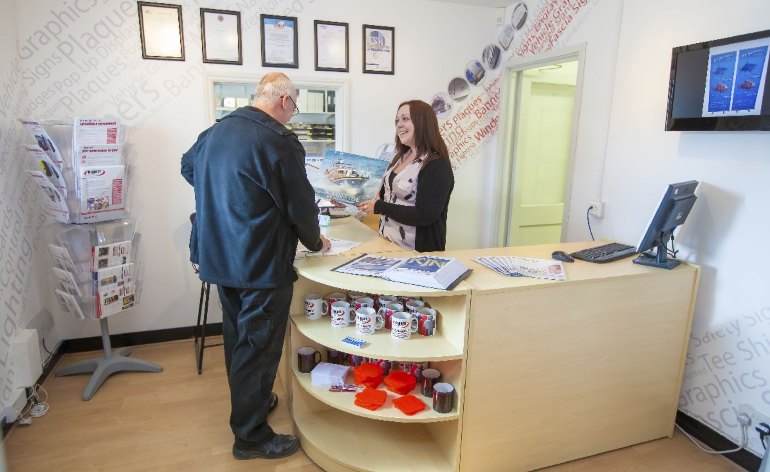Here at Impact Signs we offer a wide range of engraved and printed metal nameplates and plaques, but with so many different options, how do you know which to choose? In this guide, we will explore different aspects of nameplates, including the materials used, manufacturing processes, content options, fixing methods, and their diverse applications.
What are metal nameplates?
Nameplates, or plaques as they are sometimes known, are a type of label or sign made of metal that displays information about the object it’s attached to. Versatile and durable, they can be used in a wide range of industries and for a variety of purposes. They are known for their high quality and the ability to incorporate various designs and information. This may include the name of the object but also the manufacturer, model, serial number, and any instructions or warnings related to its use.
They are often used in industrial settings because they’re durable and resistant to various environmental conditions such as heat, cold, moisture, and chemicals. They are commonly used on machinery, equipment, vehicles, buildings, or anywhere a permanent or semi-permanent label is needed.
These nameplates, made from various types of metal, typically feature engraved, embossed, etched, or printed information on the surface, often filled with colour for improved visibility.
Overall, these identifiers serve both functional and aesthetic purposes. They provide important information, contribute to branding, and sometimes even to the look and style of the product or object.
Different types of materials (stainless steel or brass)
Metal nameplates can be crafted from various materials, each offering unique properties and aesthetic appeal. Stainless steel, with either dull (brushed) or polished (mirror) finish, is a popular choice for industrial and commercial applications. Anodised aluminium, sometimes referred to as SAA, is used for its lightweight nature and versatility.
Additionally, metals such as brass can be utilised to create distinctive nameplates with their warm tones and timeless appeal. Solid brass nameplates, for example, are favoured for their classic appearance and cost-effectiveness compared to other metals.
Manufacturing processes
When it comes to manufacturing nameplates, there are several processes available, depending on the desired finish and requirements. Some of the common methods include:
- General (rotary) engraving – this is a traditional and versatile method that can achieve depth and intricate detail. It is often used for creating elegant and enduring designs.
- Digital anoprint – This process involves a full-colour CMYK print encapsulated within a sealed aluminium surface. It offers durability, versatility, and the ability to reproduce intricate designs accurately.
- Chemical etching – this process creates depth into the metal surface, which can be left natural or in-filled with traditional enamel or digital inks. This process allows for intricate detailing and customisation options.
- Laser marking – this is a fast and precise method for creating permanent marks on metal. It can also be used to add variable data, making it ideal for applications requiring sequential numbering or QR codes.
- Digital printing – This process enables surface printing of any design onto almost any material, including metal. It offers flexibility, is UV stable, suitable for outdoor use and allows for photographic quality prints.
They can then be precision laser cut to size using camera registration, ensuring a clean, burr-free, and accurate finish on each plate. They are then prepared for attachment, which can involve the addition of adhesive backing, holes for screws or rivets, or other mechanisms.
What can be included on a nameplate?
Depending on the size, metal nameplates can offer ample space for incorporating various information and features, depending on your needs. Some common uses include:
- Personal nameplate – used on doors, desks, or lockers in schools or workplaces to indicate who the space belongs to. These usually include the individual’s full name or preferred name and possibly the individual’s title or position if in a professional setting.
- Product nameplate – These are typically found on machinery, equipment, or consumer goods and may include information like:
- Manufacturer’s Name & Model Number – clearly identifying key information relating to the manufacturing process.
- Serial Numbers – unique identification numbers to track and trace products or assets.
- Sequential Numbers – useful for inventory management and control purposes.
- QR Codes – can be etched or printed onto the metal, providing a convenient way to access digital information or facilitate scanning processes.
- Barcodes – similar to QR codes, barcodes can be included to streamline data capture and identification processes.
- Part Numbers – making it easier to identify and track specific components or parts.
- Building nameplate – Typically seen at the entrance of a building or a residential home, these could include things like the name of the building or house and street address.
- Office door nameplate – found outside offices or meeting rooms, to indicate the name of the person or team that uses the room or the room’s designated purpose (like “Conference Room”).
Data plates are a specific type of product nameplate, designed to inform rather than solely identify. These may contain more detailed product information, such as:
- Model number and serial number
- Technical specifications (such as power requirements, dimensions, load capacity, etc.)
- Operating instructions
- Warnings or safety information
- Regulatory compliance markings
Fixing metal nameplates and plaques in position
When it comes to fixing the finished article to its chosen location, it can depend on the specific context, but there are various options available:
Screws or rivets
For a more permanent attachment, especially on rough surfaces or outdoors, you might screw or rivet the nameplate in place. This will require holes in the nameplate that align with the holes in the surface you’re attaching it to. Here at Impact Signs, nameplates can be manufactured with pre-drilled fixing holes.
The size and location of these holes can be specified according to your requirements. Additionally, upon request, we can provide nameplates with countersunk holes or other bespoke types of fixings. Our finishing department is equipped to tackle most customisation requests.
Adhesive
Alternatively, nameplates can be affixed using adhesive backing, also known as VHB (very high bond) which can be as secure as screws in the right environment. As an example, a lot of the large roadside signs are stuck on with VHB.
The main considerations are preparation of surface, heat and chemicals – this needs to be confirmed in order to provide the correct backing. As some products cannot be drilled, adhesive can be a great option. The best adhesive for your specific application and surface can be recommended by our team.
Welding or soldering
In some cases, such as with metal machinery or equipment, the nameplate might be welded or soldered in place. This is a permanent method of attachment and should only be done by someone with the appropriate skills and safety equipment.
Bracket or holder
In some instances, a metal nameplate can be placed into a bracket or holder that is attached to the object. This allows for the nameplate to be easily changed if needed.
Chains
Short chains with connectors are often used for items such as pipe valve tags. This can be another secure option depending on location and needs.
Where metal nameplates are used
Nameplates find applications across a wide range of industries, including but not limited to:
- Industrial Manufacturing – commonly used for product identification, asset tracking, and safety labelling in manufacturing facilities.
- Automotive – found on vehicles, displaying manufacturer logos, model names, and other pertinent information.
- Electrical and Electronics – utilised for rating plates, equipment labelling, and identification in electrical panels and electronic devices.
- Aerospace – crucial for component labelling, part identification, and compliance marking.
- Medical and Healthcare – employed in medical devices, equipment labelling, and patient identification in healthcare settings.
- Retail and Hospitality – used to enhance branding and provide a sophisticated touch in retail and hospitality environments.
- Food Industry – laser-etched stainless steel nameplates are perfect for use with food manufacturing or preparation.
In summary
Metal nameplates offer a versatile and durable solution for identification needs across various industries. With their wide range of materials, manufacturing processes, and customisation options, these nameplates can be tailored to suit specific requirements. Whether it’s digital printing on aluminium or incorporating QR codes, they offer an effective means of displaying important information.
Additionally, utilising chemical etching for brass or stainless steel designs adds a touch of elegance to any application.
We hope you’ve enjoyed our blog – for more information about how Impact Signs can help create the perfect bespoke metal nameplates for your needs, contact us now.



